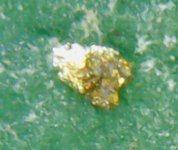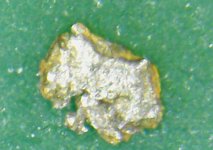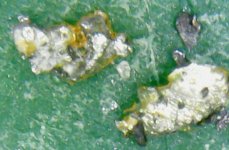tonofsteel
Jr. Member
Help Identifying If Gold Or Not In Crushed Ore?
Apologies for the poor pictures but I am using a cheap USB microscope and I need to upgrade at some point here.
I have been looking for ore as a hobby and will bring some samples home to crush from time to time. I am using a hardened steel rod in a steel pipe on a piece of 4" flat stock steel. I crush and classify through a 50 mesh screen and keep re-crushing the 50+ until it all passes through. I use a gold pan to pan down the crushed rock looking for heavies.
Panning in a stream I have found this piece of gold:

Panning the crushed rock I get pieces like this:

For test panning I wash aggressively just to see if anything is there and these pieces are really heavy. The heavies left after I crush always have this silver tinge to them on the surface.

The crushed rock "gold" always looks to be squished as well.
Is this transfer from the hardened steel shaft or am I getting fooled here? I cannot find anywhere this issue coming up for anyone else.
Edit: Also just thought that maybe the ore could have mercury or some other metal in it as well that through crushing gets mashed into the gold?
Apologies for the poor pictures but I am using a cheap USB microscope and I need to upgrade at some point here.
I have been looking for ore as a hobby and will bring some samples home to crush from time to time. I am using a hardened steel rod in a steel pipe on a piece of 4" flat stock steel. I crush and classify through a 50 mesh screen and keep re-crushing the 50+ until it all passes through. I use a gold pan to pan down the crushed rock looking for heavies.
Panning in a stream I have found this piece of gold:

Panning the crushed rock I get pieces like this:

For test panning I wash aggressively just to see if anything is there and these pieces are really heavy. The heavies left after I crush always have this silver tinge to them on the surface.

The crushed rock "gold" always looks to be squished as well.
Is this transfer from the hardened steel shaft or am I getting fooled here? I cannot find anywhere this issue coming up for anyone else.
Edit: Also just thought that maybe the ore could have mercury or some other metal in it as well that through crushing gets mashed into the gold?
Last edited:













